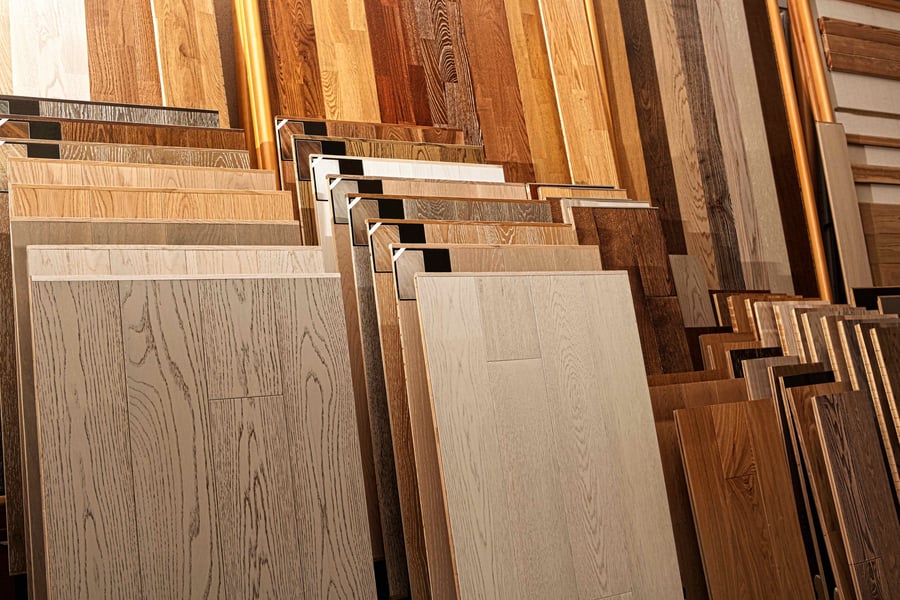10 Signs of Moisture Problems in Flooring

Flooring installers and restoration experts alike frequently have to deal with moisture problems in flooring. They have to keep an eye out for the warning signs of moisture problems in flooring. What are the warning signs of flooring moisture problems? And, how can you measure flooring moisture quickly and accurately to verify these moisture issues?
The signs of moisture problems in flooring will vary from one type of flooring to the next. Here’s a short list of 10 of the common issues related to moisture that can be found in different types of flooring:
Wood Flooring Moisture Warning Signs
Wood flooring can be significantly affected by an excess or lack of moisture. As a hygroscopic material, wood will absorb or release moisture until it reaches equilibrium with its surroundings. Some common issues that can occur when wood flooring isn’t installed at its equilibrium moisture content (EMC) include:
- Warping. Warped or buckled floors can occur when wood starts absorbing moisture. The excess moisture causes the wood to warp and pull away from the subfloor. This is usually slight, but in extreme cases, the wood can peel several inches away from the floor.
- Crowning. When there is more moisture in the center of a piece of wood flooring than the edges, the center can rise, creating a crowned appearance.
- Cupping. Here, there is more water in the edges of a wood board than the center, causing the edges to rise higher than the center. Swelling boards may also push against one another, creating an indentation that gives boards a “wavy” appearance.
- Persistent Water Condensation. If water droplets frequently appear on the surface of wood flooring without an apparent source, it might be because of excess moisture in the board being released.
- Discoloration. In many types of hardwood flooring, excess moisture can cause the wood to appear slightly darker than it should be. Splotches of darker wood can be an indication that there is moisture in the wood.
If any of these warning signs are present, the wood floor should be checked with a wood moisture meter as soon as possible. A wood moisture meter can help the user identify exactly how much moisture is in the wood so they can take appropriate remediation measures.
Warning Signs of Moisture in Concrete
It can be hard to tell at a glance whether a concrete floor is moisture-compromised. However, there are a couple of moisture warning signs that are visible with the naked eye:
- Pop-Outs. A pop-out occurs when moisture or chemicals close to the surface of a piece of concrete expand, causing the concrete to fracture. Pop-outs are left as small cavities after this happens.
- Spalling. If small chips of concrete separate from the rest of the floor, there may be moisture in the concrete that is freezing when exposed to low temperatures. Alternatively, if rebar within the concrete is too wet, it could rust and contribute to spalling as well.
Tile Flooring Moisture Warning Signs
In tile floor installations, there are a few things that can be an indication of moisture issues in the floor:
- Loose Flooring Tiles. Excess moisture in a subfloor can cause the adhesive between that subfloor and the tile to fail. Here, the tile won’t completely adhere to the subfloor, making it loose and prone to shifting.
- Musty Odors. In any kind of flooring, excess moisture can contribute to the growth of mold in the floor. This mold growth can give off a musty odor that serves as an excellent indication of excess moisture in the area.
- Pest Infestations. Another sign of excess moisture that can appear in any kind of flooring is the sudden presence of pests such as termites or ants.
The second and third warning signs in this list, musty odors and pest infestations, are almost universally applicable to all flooring types—and can also be caused by excess moisture in other materials besides the flooring.
Using Flooring Moisture Meters to Find Moisture in Floors
One of the fastest ways to pinpoint pockets of excess moisture in flooring is to use a flooring moisture meter to test the floor. However, the method of the test may vary depending on the type of flooring you’re dealing with.
For example, if you’re measuring flooring moisture in a wood flooring system, a pinless wood moisture meter might be your go-to solution. Pinless meters can rapidly test for moisture in floors without leaving pin holes at the testing site. Simply press the meter’s plate flat against the floor, take a reading, and repeat the process at different spots until you find the moisture pocket.
To get more detailed information, such as the exact depth of a moisture pocket in a wooden board, an insulated pin wood moisture meter can be used. This also can help you define the exact boundary of the moisture-compromised flooring.
In tile floors, a pinless flooring meter used in a reference scale mode could help collect fast, qualitative indications of moisture. Alternatively, it may be necessary to test the subfloor beneath the tile for indications of moisture if you need more accurate and reliable data.
When checking concrete moisture, the best solution to get readings of moisture deep in the slab is to use the ASTM F-2170 standard. This standard calls for the use of a thermo-hygrometer with in-situ probes to measure the relative humidity conditions deep in the slab—an approach that is far more reliable than taking surface-level moisture measurements with a flooring moisture meter.
Need help picking out the right moisture meter for measuring flooring moisture? Contact the experts at Delmhorst today to go over your needs and find the best precision moisture testing tools for your needs!
Subscribe to Our Blog
Post Related

What to Avoid When Testing Moisture in Your Flooring System


